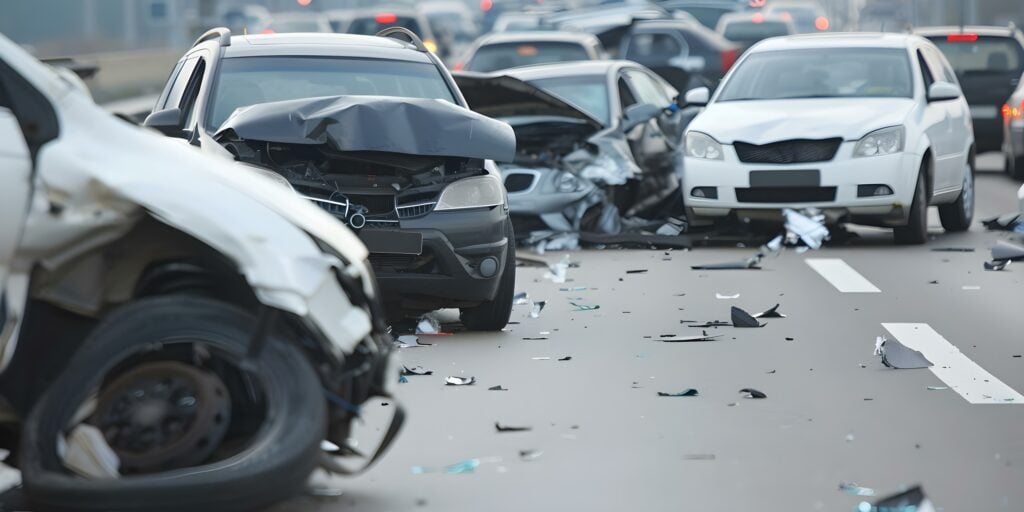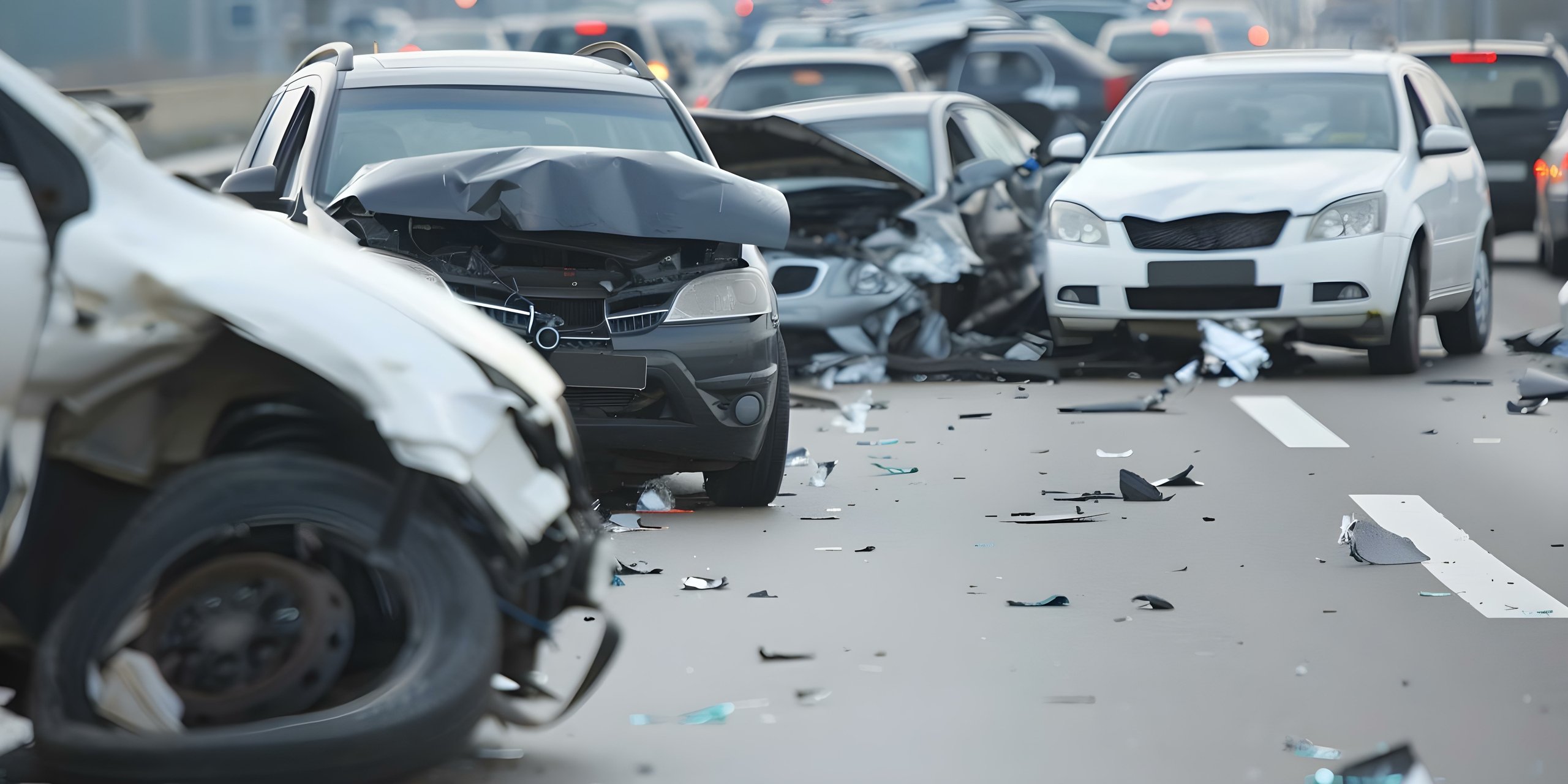How Multiple Car Pile-Ups Complicate Insurance Claims
Multi-car pile-ups are among the most confusing and stressful situations drivers can face. Unlike a simple two-vehicle fender bender, pile-ups involve numerous drivers, varying versions of events, complex legal implications, and — perhaps most frustratingly — insurance companies that don’t always agree on who is responsible.

If you’ve recently been involved in a chain-reaction accident or multi-vehicle collision, you’re probably dealing with claim delays, confusing fault determinations, and multiple insurance adjusters asking for statements. This guide breaks down how these incidents are evaluated, what the insurance process looks like, and how to protect your rights throughout.
What Is a Multi-Car Pile-Up or Chain-Reaction Crash?
A multi-car pile-up is a traffic accident involving three or more vehicles. These incidents often happen on highways, during rush hour, or under poor weather conditions such as fog, rain, or snow. A chain-reaction crash typically starts when one vehicle rear-ends another, causing a ripple effect in which additional vehicles become involved.
These accidents often result in serious injuries and extensive vehicle damage. Because so many parties are involved, determining liability becomes significantly more complicated than in a standard two-car accident. Questions about who hit whom first, who was following too closely, and whether a driver made a sudden stop all factor into how fault is assigned.
A common question drivers ask is: “I was in the middle car during a pile-up — who’s at fault?” The answer isn’t simple, and it typically depends on the laws of your state, the available evidence, and the insurance companies involved.
How Is Fault Determined in a Multi-Vehicle Accident?
Understanding Comparative Negligence
Fault determination in a multi-car pile-up often involves a legal concept known as comparative negligence. This doctrine allows multiple parties to share liability based on their respective contributions to the crash.
For example, Driver A might have braked suddenly without cause. Driver B, who was following too closely, rear-ends Driver A. Then Driver C, who was distracted or speeding, hits Driver B. In this case, Driver A could be 20% at fault, Driver B 40%, and Driver C 40%. These percentages directly affect how much each party can claim — and how much they may be liable for if sued.
In states with modified comparative negligence, you may be barred from recovering damages if you’re more than 50% at fault. In pure comparative negligence states, you can recover damages even if you’re 99% at fault — but your compensation will be reduced by your percentage of fault.
Chain-Reaction Rear-End Collisions
Rear-end collisions in pile-ups are especially tricky. While the last car in the chain often carries a large portion of the blame, that’s not always the case. Investigators will look at:
- Whether drivers were following too closely
- The speed at which each car was traveling
- Road and weather conditions
- Whether any driver braked unnecessarily or without signaling
- Dashcam footage or third-party video evidence
- Witness statements and the official police report
Drivers in the middle of the chain are often the most confused — they were hit from behind, but also may have struck the vehicle in front. That middle position can sometimes result in partial fault, especially if the driver was speeding, distracted, or didn’t maintain a safe following distance.
Role of Insurance Adjusters and Investigators
Each involved insurance company will assign an adjuster to investigate the incident. These professionals assess vehicle damage, interview drivers and witnesses, review police reports, and attempt to recreate the crash scenario. However, because each adjuster is trying to protect their own company’s financial interest, conclusions often conflict.
This leads to disputes that can delay claims, confuse policyholders, and even result in lawsuits if insurers can’t agree on a settlement.
What Happens When Multiple Drivers Share Liability?
Shared Fault Scenarios
When more than one driver is partially to blame, insurers and courts must determine how to divide the fault. Consider this example:
- Driver A abruptly stops due to a dog running into the road.
- Driver B, distracted by a text message, doesn’t stop in time and hits A.
- Driver C, who is tailgating B, crashes into them both.
In this case, Driver B may carry significant fault for distracted driving, but Driver C could also be liable for tailgating. Even Driver A could be considered partially at fault depending on the state and how the emergency stop is viewed under the law.
Shared fault doesn’t mean you won’t get compensated. But your settlement amount will likely be reduced based on your percentage of responsibility.
Impact on Insurance Payouts
The biggest challenge of shared liability is how it impacts compensation. Suppose your damages total $10,000. If you’re found to be 25% at fault in a comparative negligence state, your recovery could be limited to $7,500. If you’re over 50% at fault in a modified comparative negligence state, you might receive nothing at all.
This makes it critical to understand your legal standing and how your state handles fault distribution in car accidents.
The Insurance Claim Process After a Pile-Up
Reporting the Incident to Multiple Insurers
After a pile-up, your first step is to report the incident to your own insurance company. You may also be contacted by the insurance companies of other involved drivers. While you are obligated to cooperate with your own insurer, you’re not required to provide recorded statements to others. It’s best to consult with an attorney before speaking with another party’s insurer to avoid inadvertently admitting fault.
Understanding Subrogation
Subrogation is the process by which your insurance company, after paying your claim, seeks to recover money from the at-fault party’s insurer. This can become complex in pile-ups because fault isn’t always clear-cut, and insurers may disagree on who should reimburse whom.
This process can significantly delay your final payout — even if your claim has already been partially processed.
Common Causes of Settlement Delays
Settlement delays are extremely common in pile-up scenarios and can be caused by:
- Disagreements over who is at fault
- Multiple adjusters reaching conflicting conclusions
- Lack of cooperation from involved drivers
- Extensive vehicle damage that requires special evaluation
- Ongoing police investigations or legal claims
While simple claims may resolve in 30 days, pile-up claims often take 60–90 days or longer to settle.
What to Do If You’re the Middle or Last Car
Protecting Yourself From Fault Claims
Being in the middle or rear of a chain-reaction crash puts you in a vulnerable position. To reduce your risk of being unfairly blamed, take these steps as soon as possible after the accident:
- Photograph the entire scene, including all vehicle positions and license plates
- Obtain a copy of the police report
- Collect contact information from all involved parties and witnesses
- Save dashcam footage if available
- Note any relevant weather or road conditions
The more evidence you have, the better positioned you’ll be to prove you were not at fault.
Collecting Strong Evidence
In multi-vehicle crashes, every detail matters. Document the time of the incident, the location, the condition of your vehicle before and after the crash, and any injuries you sustained. Keep all medical records, repair estimates, and written communications with insurers.
All of this information can help clarify what happened — and protect you in case of a legal dispute or subrogation conflict.
What to Expect From Insurance Adjusters
Conflicting Fault Determinations
Insurance adjusters are not neutral third parties. Each one is working to minimize their company’s financial exposure. This often leads to different conclusions from each adjuster about what happened — and who is liable. It’s not unusual for an adjuster to deny fault altogether or assign it entirely to another driver, even when the evidence suggests otherwise.
Dispute Resolution and Legal Help
If you feel your insurer is treating you unfairly, or you’re being blamed despite being rear-ended or pushed into another vehicle, it may be time to seek legal help. An experienced car accident attorney can:
- Review the crash investigation and evidence
- Challenge unfair fault assessments
- Negotiate directly with insurance companies
- Represent you in legal proceedings if necessary
Legal support is particularly valuable when facing aggressive adjusters, being blamed unfairly, or waiting months for a settlement.
Common Problems After Multi-Car Collisions
- Being contacted by multiple adjusters with conflicting requests
- Waiting months for claim approval due to subrogation
- Disputes over how much each insurer is responsible for
- Being blamed unfairly as the middle or rear vehicle
- Navigating a complex legal process without guidance
Frequently Asked Questions (FAQs)
Who pays for damage in a multi-car pile-up?
The answer depends on how fault is determined and whether you live in a fault or no-fault state. In fault states, the at-fault driver’s insurance typically covers the damages of others involved, either through liability coverage or subrogation if your insurer pays first. However, in multi-vehicle collisions, fault is often shared, and each party’s insurer may initially pay for their policyholder’s damages before negotiating recovery between themselves. This process can take time, especially if liability is unclear.
Can I still be held responsible if I was rear-ended in a pile-up?
Yes, it’s possible. While rear-end collisions often place blame on the driver who struck from behind, that isn’t a hard-and-fast rule in pile-up accidents. If you were following too closely, failed to maintain your brakes, or stopped suddenly without justification, you could be assigned partial liability. Additionally, if you were pushed into the car in front of you, insurers will investigate whether you could have done anything to minimize the impact.
How long does it typically take to settle an insurance claim after a pile-up?
The settlement timeline varies depending on the complexity of the crash. For relatively straightforward cases with clear liability, claims may settle within 30 to 60 days. However, in multi-car accidents with shared fault, multiple adjusters, or ongoing subrogation processes, claims can stretch out over several months. Delays are common when insurance companies dispute liability or when further investigation is needed to assess damages and injuries.
What happens if one of the drivers in the pile-up was uninsured?
If an uninsured driver was involved and is found to be at fault, your ability to recover damages will depend on your coverage. If you carry uninsured motorist (UM) coverage, your insurer may cover the damages and then pursue the at-fault driver for reimbursement. Without UM coverage, you might be forced to sue the uninsured driver directly, which often leads to limited recovery if the driver lacks the financial means to pay.
Is a police report enough to prove I wasn’t at fault?
A police report can be helpful, but it is not definitive proof of fault. Insurance companies conduct their own investigations and may weigh the police report along with other evidence such as photographs, witness statements, vehicle damage analysis, and dashcam footage. While a report stating that another driver was cited or appeared responsible can support your claim, insurers are not bound by the conclusions of law enforcement officers.
Contact Lawlor, White & Murphey Today
If you’ve been involved in a multi-vehicle collision and are struggling with claim delays, insurance disputes, or confusing liability decisions, don’t go it alone. The stakes are too high, and your rights could be compromised.
Contact Lawlor, White & Murphey today for a free consultation. A legal professional can help you navigate fault determinations, dispute unfair assessments, and ensure you receive the compensation you’re entitled to.
